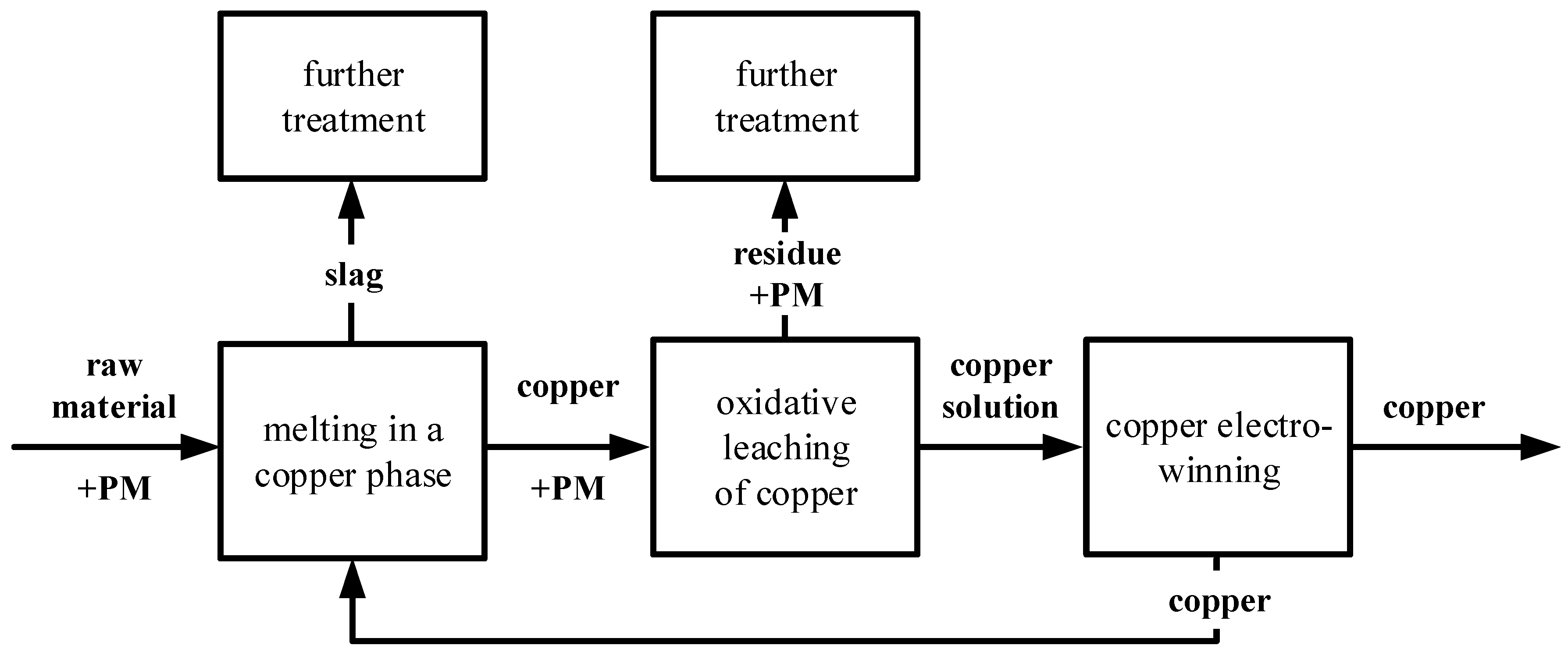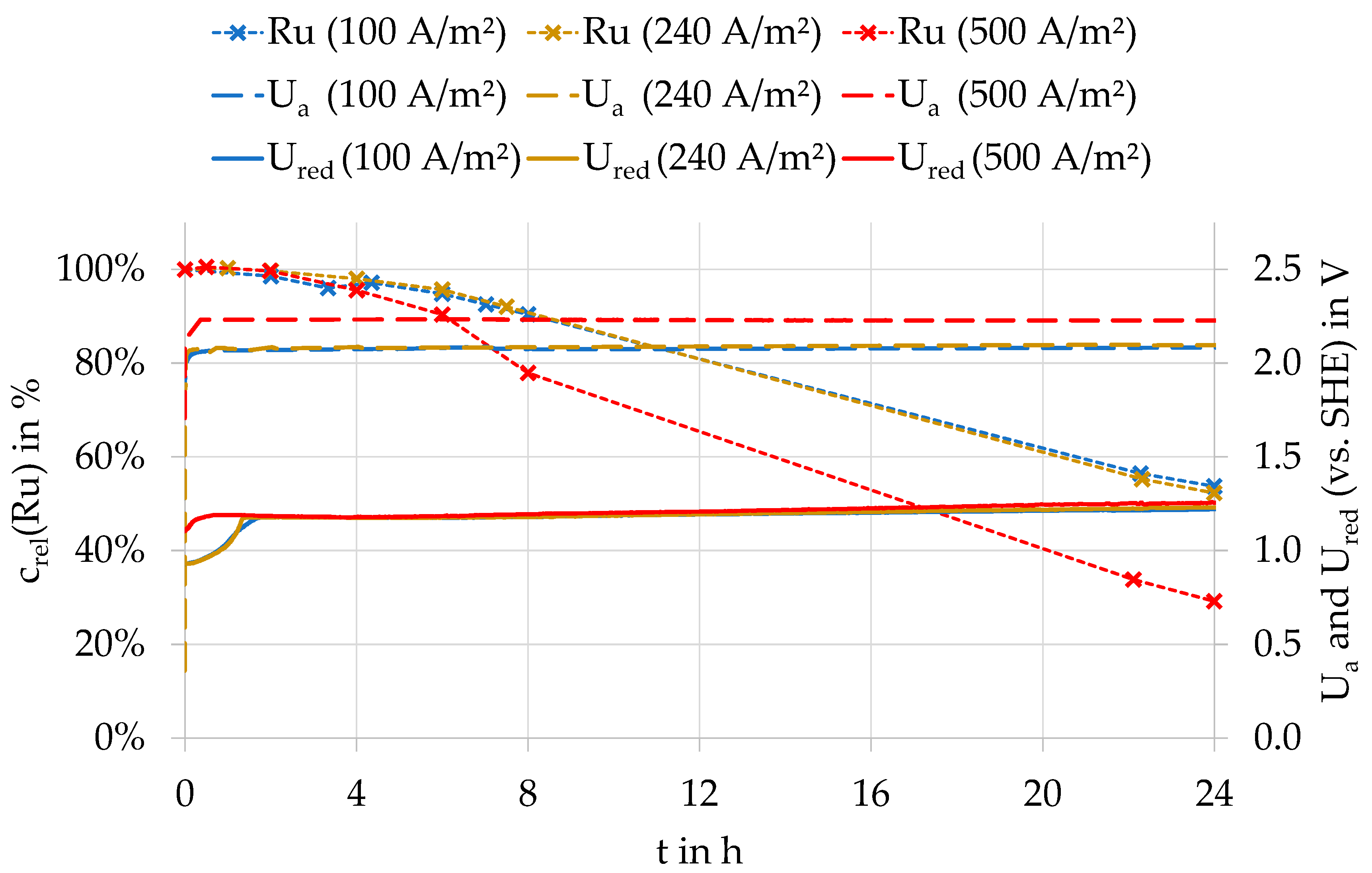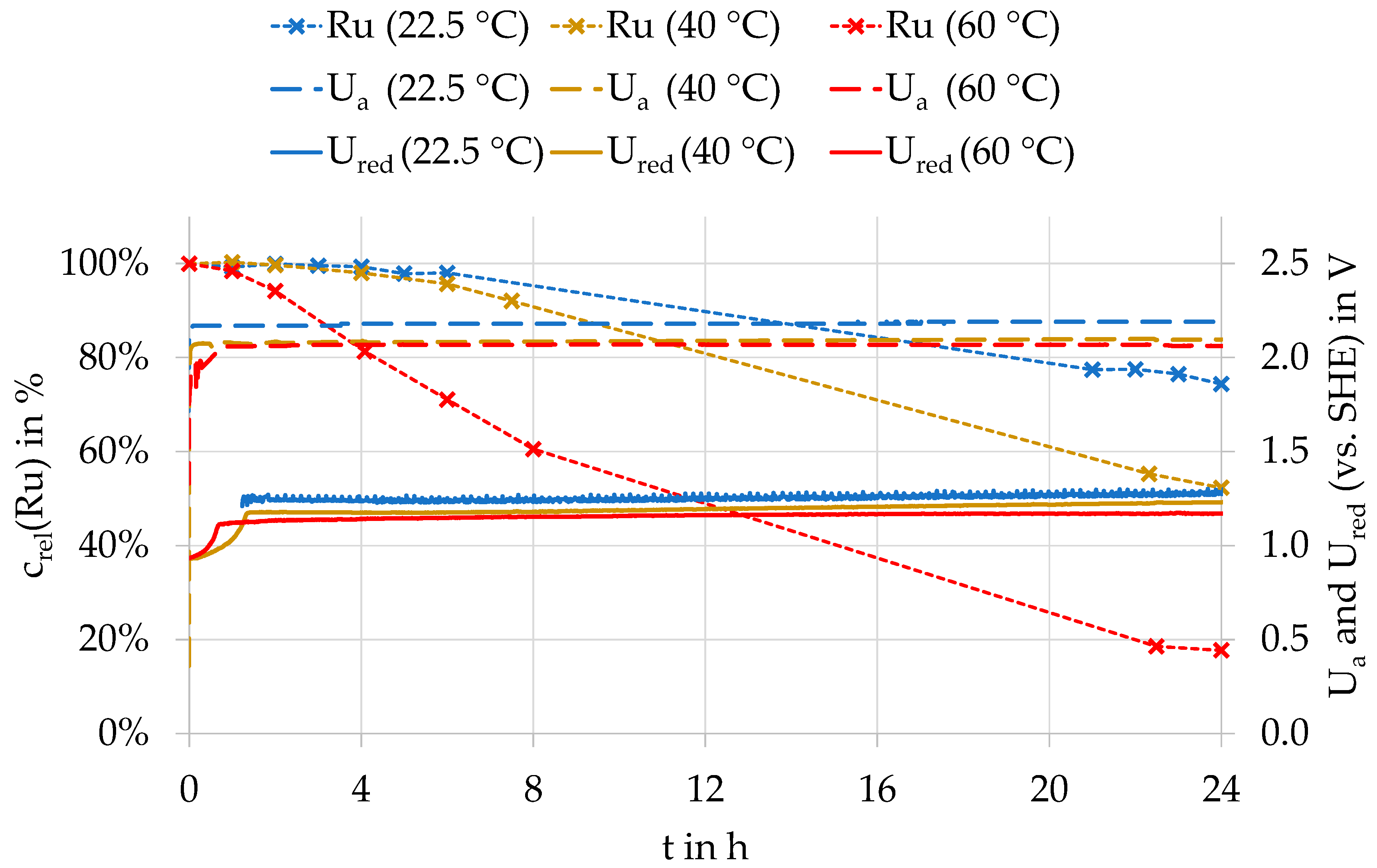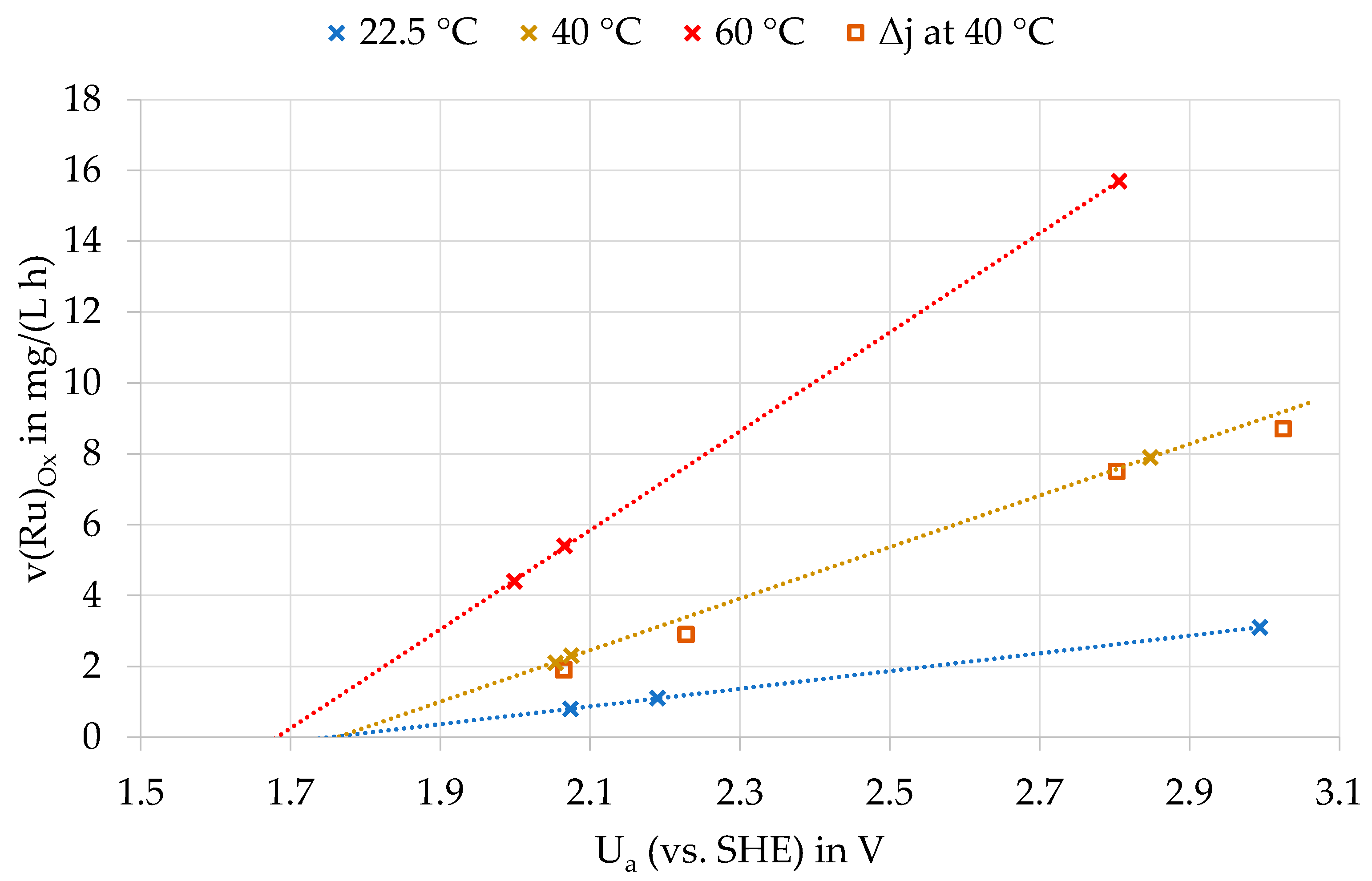The Behavior of Ruthenium in Copper Electrowinning
Abstract
:1. Introduction
2. Literature Evaluation
2.1. Chemistry of Ruthenium
2.2. Processes on Insoluble Anodes for Metal Electrowinning
3. Investigation of the Oxidation of Ruthenium in Copper Electrowinning
3.1. Experimental Setup and Experimental Procedure
3.2. Influence of Current Density
3.3. Influence of Temperature
3.4. Influence of the Anode Potential
4. Studies on the Oxidants Formed at the Anode
4.1. Experimental Setup and Experimental Procedure
4.2. Results
5. Summary of Results and Conclusions for Copper Electrowinning Process
- Improving the conditions concerning the dissolution of ruthenium during oxidative leaching in sulfuric acid, hence minimizing the entry of ruthenium into copper electrowinning.
- Running the copper electrowinning at low temperatures and with low anodic potentials, using anode materials with a low oxygen overvoltage, as well as using additives that decrease the anodic potential (such as Co(II)).
- Adding easily oxidizable compounds to the electrolyte, e.g., ascorbic acid or Fe2+ ions were already realized [13], which are oxidized by anodically formed oxidants before ruthenium.
Author Contributions
Funding
Data Availability Statement
Acknowledgments
Conflicts of Interest
References
- Marscheider-Weidemann, F.; Langkau, S.; Eberling, E.; Erdmann, L.; Haendel, M.; Krail, M.; Loibl, A.; Neef, C.; Neuwirth, M.; Rostek, L.; et al. DERA Rohstoffinformationen, Rohstoffe für Zukunftstechnologien 2021; DERA Rohstoffinformationen 50; DERA: Berlin, Germany, 2021; pp. 20–21. ISBN 978-3-948532-47-5. [Google Scholar]
- Hagelüken, C. Recycling of electronic scrap at Umicore—Precious metals refining. Acta Metall. Slovaca 2006, 12, 111–120. [Google Scholar]
- Povar, I.; Spinu, O. Ruthenium redox equilibria, 2. Thermodynamic analysis of disproportionation and comproportionation conditions. J. Electrochem. Sci. Eng. 2016, 6, 135–143. [Google Scholar] [CrossRef] [Green Version]
- Povar, I.; Spinu, O. Ruthenium redox equilibria, 3. Pourbaix diagrams for the systems Ru-H2O and Ru-Cl-H2O. J. Electrochem. Sci. Eng. 2016, 6, 145–153. [Google Scholar] [CrossRef] [Green Version]
- Seddon, E.A.; Seddon, K.R. The Chemistry of Ruthenium, 1st ed.; Elsevier Science Publishers B.V.: Amsterdam, The Netherlands, 1984. [Google Scholar]
- Rard, J.A. Chemistry and Thermodynamics of Ruthenium and some of its Inorganic Compounds and Aqueous Species. Chem. Rev. 1985, 85, 1–39. [Google Scholar] [CrossRef]
- Jaskula, M. Das Verhalten der Platinmetalle während der Kupferraffinationselektrolyse. Erzmetall 1989, 42, 117–124. [Google Scholar]
- Gmelin-Institut. Gmelins Handbuch der Anorganischen Chemie, 8th ed.; Verlag Chemie: Weinheim, Germany, 1970; Volume 63. [Google Scholar]
- Yoshii, K.; Hideo, Y.; Histeru, O. The electrodeposition of ruthenium from a ruthenium (III) and ruthenium (IV) solution and a fission products solution. Bull. Chem. Soc. Jpn. 1965, 38, 1911–1915. [Google Scholar] [CrossRef] [Green Version]
- Remy, H. Lehrbuch der Anorganischen Chemie, 10th ed.; Geest & Portig: Leipzig, Germany, 1959. [Google Scholar]
- Stelter, M.; Hein, K.; Bauer, I. Neue Bleianodenwerkstoffe für die Metallgewinnungselektrolyse. Erzmetall 1998, 51, 281–289. [Google Scholar] [CrossRef]
- Hollemann, A.F.; Wiberg, E.; Wiberg, N. Lehrbuch der Anorganischen Chemie, 102nd ed.; Walter de Gruyter: Berlin, Germany, 2007; pp. 1666–1680. [Google Scholar]
- Thiere, A. Ein Beitrag zum Oxidationsverhalten von Ruthenium Während einer Kupfergewinnungselektrolyse. Ph.D. Thesis, Technische Universität Bergakademie Freiberg, The University of Ressources, Freiberg, Germany, 2018. [Google Scholar]
- Benzo, Z.; Salas, J.; Araujo, P.; Camardiel, A.; Carrión, N. Estimination of experimental parameters for the determination of ruthenium by flame atomic absorption spectroscopy. Chemom. Intell. Lab. Syst. 1998, 40, 109–117. [Google Scholar] [CrossRef]
- Soni, B.D.; Patel, U.D.; Agrawal, A.; Ruparelia, J.P. Application of BDD and DSA electrodes for the removal of RB 5 in batch and continuous operation. J. Water Process Eng. 2017, 17, 11–21. [Google Scholar] [CrossRef]
- Waclawek, S.; Lutze, H.V.; Grübel, K.; Padil, V.V.T.; Černík, M.; Dionysiou, D.D. Chemistry of persulfates in water and wastewater treatment: A review. Chem. Eng. J. 2017, 330, 44–62. [Google Scholar] [CrossRef]
- Serrano, K.; Michaud, P.A.; Comninellis, C.; Savall, A. Electrochemical preparation of peroxodisulfuric acid using boron doped diamond thin film electrodes. Electrochim. Acta 2002, 48, 431–436. [Google Scholar] [CrossRef] [Green Version]
- Thiere, A. Behaviour of Ruthenium in Copper Electrowinning. Diploma Thesis, Technische Universität Bergakademie Freiberg, The University of Ressources, Freiberg, Germany, 2014. [Google Scholar]









| Name | Chemical Formula | E0 in V | |||
|---|---|---|---|---|---|
| hydroxyl radical | 2.8 | ||||
| sulfate radical | 2.6 | ||||
| atomic oxygen | 2.42 | ||||
| ozone | 2.08 | ||||
| peroxodisulfate ion | 2.01 | ||||
| hydrogen peroxide | 1.76 | ||||
| chlorous acid | 1.57 | ||||
| chlorine dioxide | 1.50 | ||||
| hypochlorite ion | 1.49 | ||||
| chlorate ion | 1.45 | ||||
| peroxymonosulfate ion | 1.44 | ||||
| perchlorate ion | 1.38 | ||||
| chlorine | 1.36 | ||||
| oxygen | 1.23 | ||||
Publisher’s Note: MDPI stays neutral with regard to jurisdictional claims in published maps and institutional affiliations. |
© 2022 by the authors. Licensee MDPI, Basel, Switzerland. This article is an open access article distributed under the terms and conditions of the Creative Commons Attribution (CC BY) license (https://creativecommons.org/licenses/by/4.0/).
Share and Cite
Thiere, A.; Bombach, H.; Stelter, M. The Behavior of Ruthenium in Copper Electrowinning. Metals 2022, 12, 1260. https://doi.org/10.3390/met12081260
Thiere A, Bombach H, Stelter M. The Behavior of Ruthenium in Copper Electrowinning. Metals. 2022; 12(8):1260. https://doi.org/10.3390/met12081260
Chicago/Turabian StyleThiere, Alexandra, Hartmut Bombach, and Michael Stelter. 2022. "The Behavior of Ruthenium in Copper Electrowinning" Metals 12, no. 8: 1260. https://doi.org/10.3390/met12081260





